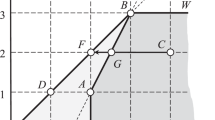Abstract
We propose an extension to the basic DEA models that guarantees that if an intensity is positive then it must be at least as large as a pre-defined lower bound. This requirement adds an integer programming constraint known within Operations Research as a Fixed-Charge (FC) type of constraint. Accordingly, we term the new model DEA_FC. The proposed model lies between the DEA models that allow units to be scaled arbitrarily low, and the Free Disposal Hull model that allows no scaling. We analyze 18 datasets from the literature to demonstrate that sufficiently low intensities—those for which the scaled Decision-Making Unit (DMU) has inputs and outputs that lie below the minimum values observed—are pervasive, and that the new model ensures fairer comparisons without sacrificing the required discriminating power. We explain why the “low-intensity” phenomenon exists. In sharp contrast to standard DEA models we demonstrate via examples that an inefficient DMU may play a pivotal role in determining the technology. We also propose a goal programming model that determines how deviations from the lower bounds affect efficiency, which we term the trade-off between the deviation gap and the efficiency gap.
Similar content being viewed by others
References
Baker, R. C. and S. Talluri. (1997). “A Closer Look at the Use of Data Envelopment Analysis for Technology Selection.” Computers & Industrial Engineering 32(1), 101-108.
Banker, R. D., A. Charnes and W. W. Cooper. (1984). “Some Models for Estimating Technical and Scale Inefficiencies in Data Envelopment Analysis.” Management Science 30(9), 1078-1092.
Banker, R. D. and R. C. Morey. (1986). “The Use of Categorical Variables in Data Envelopment Analysis.” Management Science 32(12), 1613-1627.
Byrnes, P., R. Färe and S. Grosskopf. (1984). “Measuring Productive Efficiency: An Application to Illinois Strip Mines.” Management Science 30(6), 671-681.
Charnes, A. and W. W. Cooper. (1980). “Auditing and Accounting for Program Efficiency in Non-for-Profit Entities.” Accounting Organizations and Society 5(1), 87-107.
Charnes, A., W. W. Cooper, B. Golany, L. M. Seiford and J. Stutz. (1985). “Foundations of Data Envelopment Analysis for Pareto-Koopmans Efficient Empirical Production Functions.” Journal of Econometrics 30, 91-107.
Charnes, A., W. W. Cooper and S. Li. (1989). “Using Data Envelopment Analysis to Evaluate Efficiency in Economic Performance of Chinese Cities.” Socio-Economic Planning Sciences 23(6), 325-344.
Charnes, A., W. W. Cooper and E. Rhodes. (1978). “Measuring the Efficiency of Decision Making Units.” European Journal of Operational Research, 429-444.
Charnes, A., W. W. Cooper, A. R. Lewin and L. M. Seiford. (1995). Data Envelopment Analysis: Theory, Methodology and Applications. Kluwer Academic Publishers.
Charnes, A., W. W. Cooper, Q. L. Wei and Z. M. Huang. (1989). “Cone Ratio Data Envelopment Analysis and Multi-Objective Programming.” International Journal of Systems Sciences 20, 1099-1118.
Chilingerian, J. A. (1995). “Exploring Why Some Physicians' Hospital Practices Are More Efficient: Taking the DEA Inside the Hospital.” In A. Charnes, W. W. Cooper, A. R. Lewin and L. M. Seiford (eds.), Data Envelopment Analysis: Theory, Methodology and Applications. Kluwer Academic Publishers, 167-194.
Cook, W., Y. Roll and A. Kazakov. (1990). “A DEA Model for Measuring the Relative Efficiency of Highway Maintenance Patrols.” INFOR 28(2), 113-124.
Crino, J. R., R. A. Maurer and F. Grange. (1996). “A DEA Evaluation of US Army Infantry Training Efficiency.” Working Paper, Golden, CO: Colorado School of Mines.
Dyson, R. G. and E. Thanassoulis. (1988). “Reducing Weight Flexibility in Data Envelopment Analysis.” Journal Operational Research Society 39(6), 563-576.
First, Z., S. T. Hackman and U. Passy. (1993). “Efficiency Estimation and Duality Theory for Non-Convex Technologies.” Journal of Mathematical Economics 22, 295-307.
Frazelle, E. H. and S. T. Hackman. “The Warehouse Performance Index: A Single Point Metric for Benchmarking Warehouse Performance.” Material Handling Research Center Technical Report TR-93-14, Georgia Institute of Technology, Atlanta, GA.
Giokas, D. (1991). “A Bank Branch and Bound Efficiency: A Comparative Application of DEA and the Log-linear Model.” Omega 19(6), 549-557.
Golany, B. and S. Thore. (1997). “Restricted Best Practice Selection in DEA: An Overview with a Case Study Evaluating the Socio-Economic Performance of Nations.” Annals of Operations Research 73, 117-140.
Hackman, S. T. and U. Passy. (1988). “Projectively-Convex Sets and Functions.” Journal of Mathematical Economics 17, 51-60.
Hackman, S. T., E. H. Frazelle, P. M. Griffin, S. O. Griffin and D. A. Vlatsa. (2001). “Benchmarking Warehousing and Distribution Operations: An Input-Output Approach.” Journal of Productivity Analysis 16(1), 79-100.
Petersen, N. C. (1990). “Data Envelopment Analysis on a Relaxed Set of Assumptions.” Management Science 36(3), 305-314.
Roll, Y., W. Cook and B. Golany. (1991). “Factor Weights in Data Envelopment Analysis.” IIE Transactions 23(1), 2-9.
Seiford, L. M. (1995). “A DEA Bibliography.” In A. Charnes, W. W. Cooper, A. R. Lewin and L. M. Seiford (eds.), Data Envelopment Analysis: Theory, Methodology and Applications. Kluwer Academic Publishers, 437-471.
Seiford, L. M. and R. M. Thrall. (1990). “Recent Developments in DEA.” Journal of Econometrics 46, 7-38.
Shephard, R. W. (1970). “Theory of Cost and Production Functions.” Princeton, N.J: Princeton University Press.
Sinuany-Stern, Z., A. Mehrez and A. Barboy. (1994). “Academic Departments Efficiency via DEA.” Computers & Operations Research 21(5), 543-556.
Sueyoshi, T. (1992). “Measuring the Industrial Performance of Chinese Cities by Data Envelopment Analysis.” Socio-Economic Planning Sciences 26(2), 75-88.
Sueyoshi, T. (1997). “Measuring Efficiencies and Returns to Scale of Nippon Telegraph & Telephone in Production and Cost Analysis.” Management Science 43(6), 779-798.
Thore, S. (1996). “Economies of Scale in the US Computer Industry: An Empirical Investigation Using Data Envelopment Analysis.” Journal of Evolutionary Economics 6, 199-216.
Tulkens, H. (1993). “ON FDH Efficiency Analysis: Some Methodological Issues and Applications to Retail Banking, Courts and Urban Transit.” Journal of Productivity Analysis 4(1/2), 183-210.
Vlatsa, D. A. (1995). “Data Envelopment Analysis with Intensity Restrictions.” Unpublished Ph.D. Thesis, Georgia Institute of Technology, Atlanta, Georgia, USA, September.
Author information
Authors and Affiliations
Rights and permissions
About this article
Cite this article
Bouhnik, S., Golany, B., Passy, U. et al. Lower Bound Restrictions on Intensities in Data Envelopment Analysis. Journal of Productivity Analysis 16, 241–261 (2001). https://doi.org/10.1023/A:1012510605812
Issue Date:
DOI: https://doi.org/10.1023/A:1012510605812




